
I hope the Combat Side Stroke Guide I have compiled will be helpful to you.
『Combat Side Stroke』?
Combat Side Stroke or Combat Swimmer Stroke, CSS for short, is a swimming technique used primarily by Navy SEALs and SWCC and the U.S. Army Combat Diver Qualification Course (CDQC) and other military units. This swimming technique was developed with the utmost consideration for energy conservation, efficient long-distance travel, and quietness when covert infiltration from the sea, rivers, or lakes is required. Below is a detailed description of the combat sidestroke.
Overview
The combat side stroke is a swimming technique that combines elements of the side stroke, the front crawl, and the breaststroke. It is characterized by the following three main elements.
1.Save energy and swim long distances:

- The combat sidestroke is a technique designed for swimming long distances. Energy efficiency is critical for Special Forces personnel, who are required to swim for long periods of time donning guns and equipment. This swimming technique saves energy by keeping the majority of the body underwater and minimizing drag.
2.Quietness:
- In tactical situations, you must move quietly so as not to be noticed by the enemy. Combat sidestrokes are designed to minimize splashing by reducing the motion that stirs up the water’s surface. This makes it easier to move quietly through the water and avoid detection by enemies.

3.Flexibility and Adaptability:
- This swimming technique is designed to adapt to a variety of environmental conditions. For example, it is designed to allow the swimmer to swim effectively in rough seas and strong currents with less physical exertion.
How to swim
The actual swimming technique (arm motion, leg motion, and breathing) will be explained.
1.Posture and body positioning
- For much of the time during swimming, the swimmer keeps the body on its side, vertical to the surface of the water. With one side of the body above the water (the right side if breathing on the right) and the other side in the water, it is easier to maintain balance and a more stable posture.
2. Arm motion
The arm motion of the combat side stroke can be simply described as a combination of front crawl and breaststroke.
Starting from the streamline position with both arms fully extended above your head, if you are breathing on the right side, stroke the right arm (pull arm) to the thigh in a front crawl motion.
Next, the left arm (lead arm) is pulled up to the chest in a breaststroke motion, and both arms are simultaneously extended forward in time for the kick, returning to the streamline position.
- Front arm (Lead arm): This arm (the left arm if breathing on the right) is extended forward to act as a compass to point the direction of travel and to maintain buoyancy.
- Rear arm (Pull arm):It is an important arm that creates the impetus for propulsion. Basically, it is a front crawl motion, but the major difference from crawling is the way the arm recover after stroke to the thigh.
The elbow is kept as low as possible, the wrist should be kept in the water, and hand return to the front while touching the side of the body.
Avoiding detection by the enemy is another important point unique to this swimming.
Therefore, elbow is low and wrist is always below the surface of the water to avoid being noticed by the reflection of the wristwatch.
Also, keeping the wrist in the water makes it easier to control splashing.
3. Kicking
- Kicking is by “flutter kick” or “scissor kick“.
※In Special Forces, when fins are worn, the kick is always a flutter kick.
Only when fins are not worn scissor kick is used.
Scissor kick is done at the point where the rear arm (pull arm) and front arm (lead arm) have been stroked.
The timing of the arm stroke and kick can be referred to the breaststroke.
If the timing of the arms and legs is correct, you can return to a perfect streamline position.
4. Breathing
- It is easy to take longer breaths than frontcrawl,breaststroke,butterfly (no need to mention about backstroke).Rhythmic breathing ensures a steady supply of oxygen and prevents shortness of breath during long swims.
Take a look at demo on YouTube.
Or check it out in the embedded video below.
6 steps drill of CSS
Now let’s take a look at the drill !

